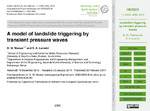A model of landslide triggering bytransient pressure waves
Abstract
Previous studies indicate that most rainfall-triggered shallow landslides are initiated by a spike in rainfall intensity, which does not usually occur at the beginning of a critical storm, within which the slide is triggered, but after several minutes (or hours) of the storm. The critical storm is also usually not positioned at the beginning of a rainfall5season, but after several days of antecedent period. Rainfall triggers landslides via rapid increase in pore water pressure, commonly associated with the change in water content. Consequently, many hydrologic pressure wave models assume that rapid pore water pressure responses are as a result of rapid infiltration of rainwater.On the contrary, this paper argues that, based on the above timings of landslide10occurrences and the knowledge that infiltration rate decays with the soil wetness, the rapid increase in pore water pressure that triggers shallow landslides is as a result ofrapid introduction of additional energy into the tension saturated (or nearly saturated)zone by the intense rainfall at the ground surface, without infiltration. Antecedent andcritical precipitations are significant in creating a tension saturated zone, necessary15for rapid transmission of the introduced energy from the ground surface to the lower soil horizons during the critical storm. These arguments are supported by a newly proposed one-dimensional diffusion mathematical model, which, when solved for the appropriate boundary conditions, can yield pore water pressure at any time and depth of a tension-saturated soil profile, without infiltration. The newly proposed diffusion20model is mathematically similar to Iverson’s model (Iverson, 2000), except that the hydraulic diffusivity parameter in the latter is substituted with a newly proposed energy diffusivity coefficient in the former. A combination of the new diffusion model and the infinite slope model can predict the stability of a shallow slope as a result of transient pore water pressure

